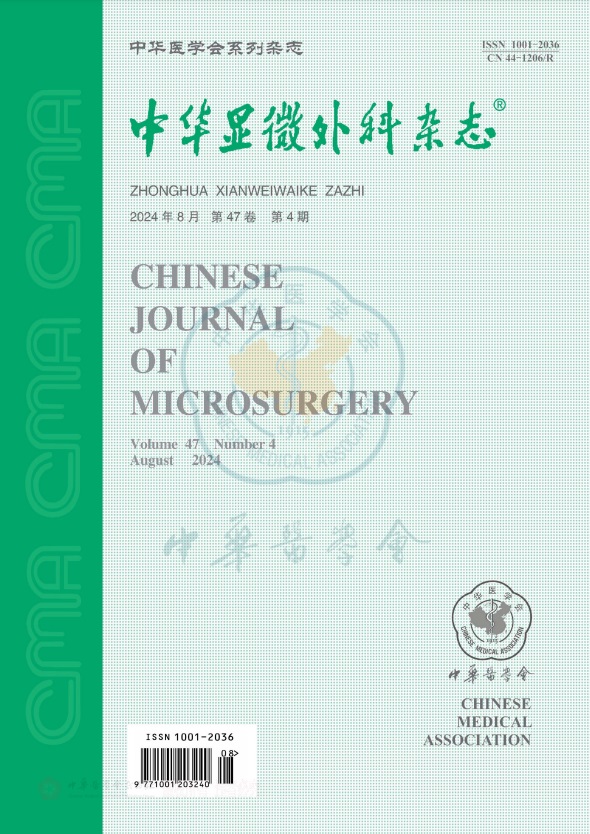Salvianolic acid B promotes the survival of abdominal island flap after ischemia-reperfusion injury in rats
引用次数: 0
Abstract
Objective To explore the therapeutic effect of salvianolic acid B (Sal B) on rat abdominal island flap after ischemia-reperfusion injury, and to explore the related mechanisms. Methods Fifty-four male Sprague-Dawley rats were randomly divided into 3 groups and rat lower abdomen island flap models were established: ①Sham-operated group (Sham group): non-blocking blood vessels, intraperitoneal injection of equal volume of saline as Sal B group; ②Model group: blocking blood vessels for 8 h, intraperitoneal injection of the same volume of saline as Sal B group; ③salvianolic acid B group (Sal B group): blocking blood vessels for 8 h, intraperitoneal injection of 40 mg/Kg of Sal B per day. Seven days after continuous drug administration, the survival rate of the flaps in each group was evaluated, and then the animals from each group were sacrificed for the specimens which were used for the following tests: HE staining was performed to evaluate the microvessel density (MVD), and immunohistochemistry was used to detect the level of vascular endothelial growth factor (VEGF) and superoxide dismutase 1 (SOD1). The contents of superoxide dismutase SOD and malondialdehyde (MDA) in flap tissue were tested using the corresponding kit. Results Seven days after flap operation, the survival rate of Sal B group flap[(65.62±13.20)%] was significantly higher than that of the model group, while HE staining showed an increase in MVD in Sal B group [(28.27±3.19)/mm2 and (15.79±6.12)/mm2, respectively]. The differences were statistically significant (P<0.05) . Moreover, immunohistochemistry demonstrated that the expression of VEGF and SOD1 obviously increased in Sal B group, and the content of SOD increased significantly. In addition, the expression of MDA decreased after Sal B treatment. The differences were statistically significant (P<0.05) . Conclusion Sal B is able to increase the expression of VEGF and SOD in the rat abdominal island flaps after ischemia-reperfusion injury, to reduce the content of MDA, and then to promote survival rate of rat abdominal island flap. Key words: Salvianolic acid B; Island flap; Angiogenesis; Oxidative stress; Rat丹酚酸B促进大鼠缺血再灌注后腹部岛状皮瓣的存活
目的探讨丹酚酸B (salvianolic acid B, Sal B)对缺血再灌注损伤大鼠腹部岛状皮瓣的治疗作用,并探讨其作用机制。方法将54只雄性sd - dawley大鼠随机分为3组,建立大鼠下腹部岛状皮瓣模型:①假手术组(Sham组):血管不阻塞,腹腔注射等体积生理盐水作为Sal B组;②模型组:阻断血管8 h,腹腔注射与Sal B组等量生理盐水;③丹酚酸B组(Sal B组):阻断血管8 h,每天腹腔注射Sal B 40 mg/Kg。连续给药7天后,评估各组皮瓣的存活率,然后处死各组动物,标本用于以下检测:HE染色评估微血管密度(MVD),免疫组化检测血管内皮生长因子(VEGF)和超氧化物歧化酶1 (SOD1)水平。采用相应的试剂盒检测皮瓣组织超氧化物歧化酶SOD和丙二醛(MDA)的含量。结果皮瓣术后7 d, Sal B组皮瓣存活率[(65.62±13.20)%]明显高于模型组,HE染色显示Sal B组MVD升高[分别为(28.27±3.19)个/mm2和(15.79±6.12)个/mm2]。差异有统计学意义(P<0.05)。免疫组化结果显示,Sal B组VEGF、SOD1表达明显升高,SOD含量明显升高。此外,Sal B处理后MDA的表达降低。差异有统计学意义(P<0.05)。结论Sal B能提高缺血再灌注损伤大鼠腹部岛状皮瓣中VEGF和SOD的表达,降低MDA的含量,从而提高大鼠腹部岛状皮瓣的存活率。关键词:丹酚酸B;岛状皮瓣;血管生成;氧化应激;老鼠
本文章由计算机程序翻译,如有差异,请以英文原文为准。
求助全文
约1分钟内获得全文
求助全文
来源期刊
CiteScore
0.50
自引率
0.00%
发文量
6448
期刊介绍:
Chinese Journal of Microsurgery was established in 1978, the predecessor of which is Microsurgery. Chinese Journal of Microsurgery is now indexed by WPRIM, CNKI, Wanfang Data, CSCD, etc. The impact factor of the journal is 1.731 in 2017, ranking the third among all journal of comprehensive surgery.
The journal covers clinical and basic studies in field of microsurgery. Articles with clinical interest and implications will be given preference.

 求助内容:
求助内容: 应助结果提醒方式:
应助结果提醒方式:


